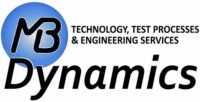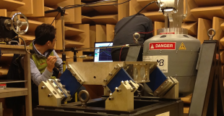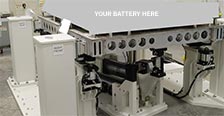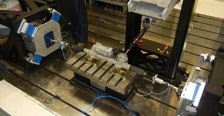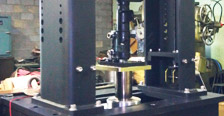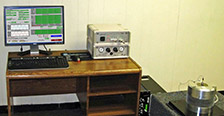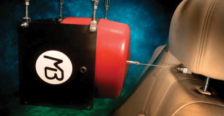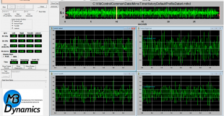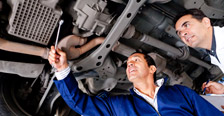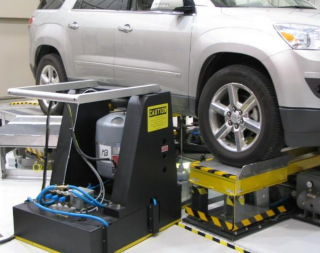 MB Dynamics delivers effective, low-cost, and quiet excitation technology to root source S&Rs in vehicles, trimmed bodies, subsystems and components, including 4 poster test rigs. MB’s patented Direct Body Excitation (DBE) Road Simulator and Dynamic Vehicle Torquer (DVT) are advanced vehicle road simulation technologies which help detect vehicle S&Rs during development, launch, and production.
MB Dynamics delivers effective, low-cost, and quiet excitation technology to root source S&Rs in vehicles, trimmed bodies, subsystems and components, including 4 poster test rigs. MB’s patented Direct Body Excitation (DBE) Road Simulator and Dynamic Vehicle Torquer (DVT) are advanced vehicle road simulation technologies which help detect vehicle S&Rs during development, launch, and production.
The MB DBE technology excites directly into the vehicle body rather than through the tire patch. Thus it takes only a fraction of the forces to excite BSRs in the vehicle interior compared to forces required from long-stroke, tire-coupled 4-poster test rigs (hydraulic/electric). Thus, the DBE technology applies only the forces and accelerations into the body that are needed to excite BSRs. Tire-coupled test rigs apply high forces and high accelerations into the tire patch and the suspension then attenuates and dampens those forces. The DBE technology is much more energy efficient and lower cost and MUCH quieter yet still effective at finding BSRs. DBE technology excites suspension BSRs but not at high displacements and high forces.
All solutions offered by MB Dynamics are further accompanied by the necessary hardware and software to ensure seamless integration, along with the value-added benefits of full engineering support, offered by one of the industry’s most experienced engineering teams. This expertise is made available to MB Dynamics customers locally in more than a dozen countries.
Full Vehicle Squeak & Rattle Detection Sheet: Download PDF
Highlights
- Patented Direct Body Excitation (DBE) into body at 2 stiff locations, 1 @ front & 1 @ rear
- Since excitation is not thru tire & suspension, forces & displacements are much less than 4-posters
- Quiet compared to 4-poster: no wheel pan slap; no servo-valve hiss; no high displacement noise
- PC control of vibration response to road measured drive-files at door hinge / A-pillar and shock tower or trunk, under MIMO control
- Higher frequency energy (up to 150 Hz) excites S&Rs not found with road simulators, < 50 – 70 Hz
- Realism: physically feels like, audibly sounds like, road
- Safe: no 215 bar oil pressure; no disposal of used oil
- Safe: get in & out during test or even get under vehicle
- Same equipment can be used for full vehicle and subsystem/component BSR excitation
- Use in factory, quiet room, or environmental chamber: -40oC to +65oC
- Use on body-on-frame vehicles weighing 3,800 kg
- 15+ years of experience at different OEMs: Hyundai, BMW, GM, Daimler, Mahindra, VW, Tesla
- Dynamic Vehicle Torquer (DVT) inputs large-displacement body twist or torsion, simulating twist ditch and low-speed curb impacts
- Excites suspension & mount noises, rubber & seal itches, and body creaks
- Air spring actuators provide up to 200mm p-p under each wheel
- MIMO displacement control of each of 4 wheels, controls displacement
- DVT wheel pans support vehicle during DBE
- Front wheel pans move for various wheelbases and are wide enough for all tracks
Strengths
- Effective finding BSRs: > 90% correlation to BSRs heard on road (customer proprietary data)
- Effective finding 85% — 90% of Interior BSRs plus most exterior suspension & exhaust noises
- DBE is quiet for S&R: 30-35 dBA inside vehicle during test
- Quiet therefore effective making good subjective evaluations and objective BSR measurements
- High frequency excitation energy up to 150 Hz excites interior and external BSRs
- Low frequency excitation energy down to 3 – 5Hz reproduces Belgian Block-types of surfaces
- Control parameters: Road-load acceleration time history, road-measured PSD random vibration, sine vibration; excellent acceleration fidelity between road measured inputs and DBE inputs
- Control parameters: Acceleration control for DBE to 150Hz, easily acquired at RLDA locations
- High fidelity and low signal distortion produces realistic excitation and correlation to road tests
- Realism generates high acceptance; physically feels like and audibly sounds like riding on the road
- Low equipment & facility costs provide excellent ROI for 85% — 90% of annoying noises
- DVT is quiet for S&R: 45– 50 dBA inside vehicle during test (quieter than 4-poster)
- DVT provides DC – 3Hz motion into tires
- Requires no seismic mass nor pit (but can be used with pit); can operate on smooth, flat 200mm thick factory floor;
minimal disruption to facility; easily relocated in factory or lab - Effective for BSR Aging (customer-equivalent kilometer accumulation)
- Negligible energy consumption: draws power only when actually exciting a vehicle
- Operates in environmental chamber: -40 degC to +65 degC
- Virtually no maintenance; simple to operate
Controllability and Road Simulation
- Replicate real driving conditions using proving ground surfaces, assembly plant tracks, and local S&R roads
- Control to acceleration time histories, PSD random spectra, speed sweeps from 0–25 mph/kph, sine vibration
- Reproduce random-like vibration, chuckhole-type transient events, periodic inputs, & speed-dependent inputs
- Use remote control mouse from inside the vehicle to repeat road surfaces over & over to identify root cause(s)
- Vary amplitudes from 25% to 150% of recorded accelerations to find/fix amplitude-dependent S&Rs
- Sequence, then link, different roads into corporate test procedures or vehicle-specific excitation conditions
Customer Testimonials
“Your team has done an excellent job in putting together a viable S&R assessment/root cause
determination tool. We have the potential to significantly reduce the root cause/source determination of squeaks and rattles. This will result in a better quality product and higher levels of customer satisfaction. I can see significant improvements concerning (1) redundant S&R road testing, (2) time required for rapid and accurate S&R assessments and corrective action determination and validation, and (3) enhanced end-of-the-line throughput to name but a few.”
“The new interface, which allows the plants to select any portion of the test that they wish to run, or the entire test, is a big time saver and provides really good results. The 9, 10 and 11-mile variations was surprisingly impressive.Giving the plants the ability to adjust the amplitude to > than 100% was another nice bonus that will also help in root cause analysis. All told, I think we definitely have a solid piece of equipment that will help us improve the quality of our vehicles.”
